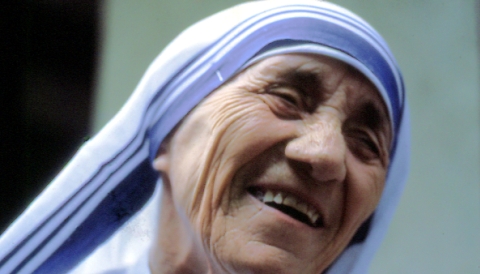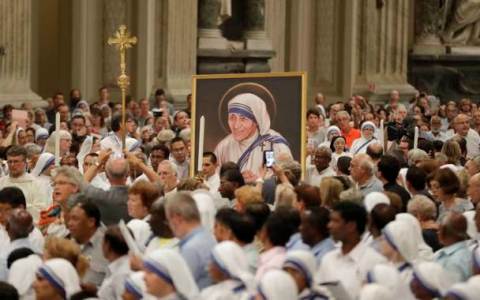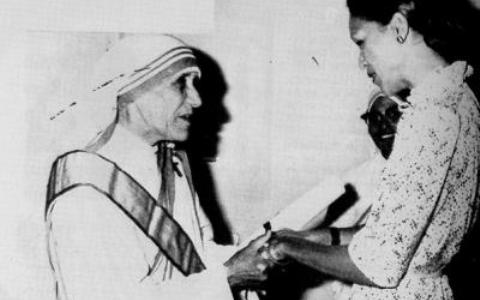Mother Teresa: the making of a saint
by - 7th September 2016

‘MOST blessed Father, Holy Mother Church, beseeches your Holiness to enroll the Blessed Teresa of Calcutta among the saints, that she may be invoked as such by all the Christian faithful.’
With these words, Cardinal Angelo Amato, the Prefect of the Congregation for the Causes of Saints petitioned Pope Francis to declare Mother Teresa of Calcutta a saint.
There are five stages in the Catholic Church’s ‘canonization’ – the declaration that a saint is in heaven, and that their name may be included in the roll of the names of saints.
In the first stage, a local bishop investigates the life and reputation of a candidate of reputed holiness, usually at least five years after the candidate’s death. In the case of Mother Teresa, Pope John Paul II waived this waiting period.
If the bishop’s report is satisfactory, he transmits it to the Congregation for the Causes of the Saints, whose Prefect then gives the title ‘servant of God’ and establishes church procedures for a thorough investigation, appointing a ‘Postulator’ who will present the case for sanctity and a ‘promotor fidei’ (promoter of the faith, popularly known as the ‘devil’s advocate’) whose purpose it is to test it with utmost rigour.
In Mother Teresa’s case, the Postulator is Fr Brian Kolodiejchuk MC.
The Prefect may then declare the candidate to have shown a life of ‘heroic virtue’.
If it can be shown to the Congregation that prayers offered to the candidate have resulted in a miracle, typically an irreversible healing of a medically unexplainable sort, the candidate can then be ‘beatified’ and given the title ‘blessed’. At this point, local devotion is formally encouraged.
Canonization, the public declaration that the saint is in heaven and possesses the vision of God is the final step in the process, inviting the whole Church to join in devotion to the saint.
Life

Describing herself, Mother Teresa said ‘by blood, I am Albanian. By citizenship, an Indian. By faith, I am a Catholic nun. As to my calling, I belong to the world. As to my heart, I belong entirely to the Heart of Jesus’.
She was born in 1910 and christened Agnes Gonxha Bojaxhiu in Skopje - then in the Ottoman Empire, now the capital of Macedonia. By age 18, Gonxha was determined to become a missionary and joined the Sisters of Loreto in Ireland.
She was given the name Sister Mary Teresa after St Thérèse of Lisieux, also known as“The Little Flower”. She left Ireland for India in December 1928, and arrived in Calcutta in January 1929.
Eight years later she took her solemn vows and became known as Mother Teresa. She was first a teacher and then principal of St Mary’s School.
On a train ride to Darjeeling in 1946, she was overcome with what she termed her ‘call within a call’ and after a series of visions was asked by Jesus to found the Missionaries of Charity, which would serve the poorest of the poor, for whose love Jesus thirsted.
In 1948 she left Loreto and entered the world of Calcutta’s slums to serve.
Her work inspired others. Some of her former students joined her and the word spread. By 1979 she was globally renowned and received the Nobel Peace Prize.
She counted Princess Diana and President Reagan among her friends – and knew and praised the Duvaliers, dictators of Haiti, too,
In 1997, her Sisters were at work in 123 countries around the world. That year she died receiving a state funeral. Now she has been declared a saint.
Criticism

As with many people considered especially holy, Teresa’s life has often been discussed in terms of hushed veneration - and also harshly criticised by the unimpressed.
The British journalist Malcolm Muggeridge recounted an interview with Mother Teresa in the House of the Dying, a dim spot where the television director had been uncertain he could film.
When the film was developed, a brilliant light illuminated the footage of her work. Muggeridge proclaimed this the first television miracle - his cameraman explained it as the result of a new and sensitive form of film produced by Kodak.
It was this adulatory overkill and his own sceptical outlook which brought Christopher Hitchens to investigate the Mother Teresa phenomenon, first in his video documentary Hell’s Angel, and then in a follow-up book, The Missionary Position.
Above all, he criticised her for neglecting to provide sanitary surroundings and medical aid to many of those she cared for, preferring to concentrate on their souls rather than their bodies. The reuse of needles was a particular complaint.
Since her death, her Sisters have indeed improved their level of medical training, an implicit acknowledgment that Hitchens had a point.
Charism
To be fair to Teresa, she herself saw her mission as one of bringing Christ’s love to the poorest of the poor, to comfort and be with them offering them Christ’s love and salvation in the extremity of their destitution. Attending to their medical needs was always secondary.
Saints, and the founders of religious societies such as the Sisters of Charity, are generally understood within Catholicism to have specific ‘charisms’ – particular aspects of Christ’s love which it is their gift to express.
Each saint and religious order represents, you might say, one specific wavelength of the light of love.
Revd Joseph Langford, who with Mother Teresa founded the priestly branch of the Missionaries of Charity, described her charism thus:
‘By serving the poor through "small things done with great love," she wanted to imitate him who came to serve rather than to be served. These humble works of love aimed not so much at medical expertise or the righting of social ills, nor even at producing verifiable results, but rather at the "salvation and sanctification" of the poorest of the poor.’
Hitchens’ bitter criticism and Teresa’s own nuanced insight into her purpose may not be so very far apart in content after all.
For many, Mother Teresa is simply an inspiration, and her Catholicism, even her Christianity is secondary to her humility and service – her name is spoken in the same breath as those of Gandhi, Martin Luther King and the Dalai Lama.
For the sceptical, she remains the disturbing figure of love blinkered by narrow dogmatism.
And for Catholics who venerate her, she is now, simply and forever, Saint Teresa of Calcutta.
